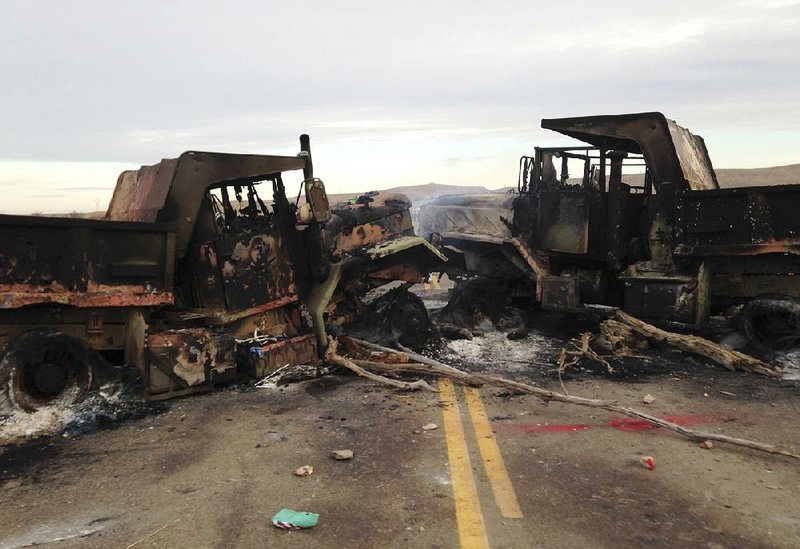CANNON BALL, N.D. -- Protesters ousted from private land where they tried to block construction of the Dakota Access oil pipeline burned vehicles and built roadblocks along a North Dakota state highway where they faced off Friday with authorities.
Officers with bullhorns commanded the protesters to leave the roadway, but the approximately two dozen people stood in defiance with their arms in the air. The confrontation came a day after hundreds of law enforcement officers forced out a larger encampment of activists in what was the most chaotic turn in the monthslong protest against the pipeline, which the Standing Rock Sioux Tribe and others argue could endanger water supplies and disturb cultural sites.
One roadblock on North Dakota 1806 included a burned SUV and sheets of plywood, and another was made up of two burned heavy trucks on a bridge over a small creek. Numerous military vehicles and work trucks were parked in the area early Friday, and officers in riot gear were present.
Authorities did not immediately have details on damage to the bridge, or on plans to remove the roadblocks, and it wasn't immediately clear whose vehicles were burned. The state's Highway Patrol is maintaining its own traffic roadblock farther along the highway to protect the public, according to Morton County sheriff's spokesman Rob Keller.
"That is not a safe place to be," he said of the protest area.
Only a handful of people, some of them observers from Amnesty International, remained on the bridge by late afternoon after protest representatives told people to return to the main encampment.
Morton County Sheriff Kyle Kirchmeier described the protesters as "nonconfrontational but uncooperative" and credited Standing Rock Sioux tribal members for helping to ease tensions on the bridge. Kirchmeier said tribal representatives were allowed onto the private property to remove tepees.
Officers arrested one person Friday, but no details were released.
Standing Rock has waged a protest for months against the four-state, 1,200-mile pipeline being developed by Texas-based Energy Transfer Partners to carry North Dakota crude to a shipping point in Patoka, Ill.
The tribe argues it's a threat to water and cultural sites, and encampments have grown to thousands at times as its cause has drawn support from Native Americans and others from around the country, including environmentalists and some celebrities.
Standing Rock Sioux Chairman Dave Archambault condemned Thursday's removal of the protesters, calling the operation "acts of violence against innocent, prayerful people."
"We won't step down from this fight," he said.
The nearly six-hour operation to remove the encampment escalated the dispute, with officers in riot gear firing bean bags and pepper spray. No serious injuries were reported.
Morton County sheriff's spokesman Donnell Hushka said 141 people were arrested. Among those was a woman who pulled out a .38-caliber pistol and fired three times at officers, narrowly missing a sheriff's deputy, State Emergency Services spokesman Cecily Fong said. Officers did not return fire, she said.
Following Thursday's eviction, some protesters worked overnight to create the two roadblocks.
Jolene White Eagle, 56, a lifelong Cannon Ball resident, watched as law enforcement officers massed near Friday's new blockade and called the police response "nonsense."
"It reminds me of something like a foreign country, what's happened here with all the destruction," she said.
The camp that was cleared Thursday was located just to the north of a more permanent, larger encampment on federally owned land that has been the main staging area for hundreds of protesters, including Native Americans from across North America, environmentalists and some celebrities. Many of the protesters returned to that site Friday to regroup and reunite with others who had been arrested the day before.
Meanwhile, construction has been allowed to continue on private land owned by the developer, with a goal of completion by the end of the year.
A Section on 10/29/2016

